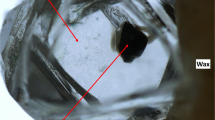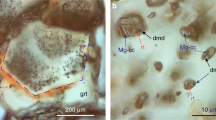Abstract
To determine the amounts of cosmic-ray produced ('cosmogenic') 3He which could be created in diamonds during their post-eruptive residence in near-surface regions, we have measured the concentration of 10Be (half life, 1.6 Myr) in an industrial diamond sample. The motivation to study cosmogenic 3He in diamonds comes from the recent observations1,2 of 3He/4He ratios in some diamonds that are even higher than meteoritic values (so-called 'planetary' helium with 3He/4He = 1.4×10−4). We measured 10Be in an alluvial diamond sample, using radiochemical and accelerator mass spectrometry (AMS) techniques. The observed 10Be concentration, 2.46 ± 0.39×106 atoms g−1, leads to an effective surface exposure of 3.3×105 yr for these diamonds. This corresponds to a substantial cosmogenic production of 3He in the alluvial diamonds, ≥=29% of the total 3He. We conclude that the high 3He/4He ratios in at least some diamonds are due to cosmogenic 3He production in near-surface regions during their residence in alluvial or weathering deposits. Thus, in order to establish that such high 3He/4He ratios existed in the mantle at one time, it is a priori necessary to study diamonds collected by underground mining methods.
This is a preview of subscription content, access via your institution
Access options
Subscribe to this journal
Receive 51 print issues and online access
$199.00 per year
only $3.90 per issue
Buy this article
- Purchase on Springer Link
- Instant access to full article PDF
Prices may be subject to local taxes which are calculated during checkout
Similar content being viewed by others
References
1. Ozima, M. el al. Geochim. cosmochim. Acta 47, 2217 (1983). 2. Ozima, M. et al. Geochem. J. 19, 127–134 (1985). 3. Bruton, E. Diamonds (Chilton, Philadelphia, 1971). 4. Honda, M., Reynolds, J. H., Roedder, E. & Epstein, S. /. geophys. Res. (in the press). 5. Lal, D. Isotope Geoscience (in the press). 6. Lal, D. & Peters, B. Handbuch der Physik XLVI/2, 551–612 (Springer, Berlin, 1967). 7. Lal, D. et al. Meteoritics 20, 403–414 (1985). 8. Lal, D. thesis, Tata Inst. Fundamental Research, Bombay (1958). 9. Honda, M. & Lal, D. Phys. Rev. 118, 1618–1625 (1960). 10. Bailey, L. E. thesis, Univ. California, Berkeley (1956). 11. Kellogg, D. A. Phys. Rev. 93, 1337–1339 (1953). 12. Nishiizumi, K. et al. Earth planet. Sci. Lett. 70, 157–163 (1984). 13. Klein, J. et al. Nucl. Instnim. Meth. 193, 610–616 (1982). 14. Legrand, J. Diamonds, Myth, Magic and Reality (Crown, New York, 1980). 15. Dawson, J. B. Kimberlites and their Xenoliths (Springer, Berlin, 1980).
Author information
Authors and Affiliations
Rights and permissions
About this article
Cite this article
Lal, D., Nishiizumi, K., Klein, J. et al. Cosmogenic 10Be in Zaire alluvial diamonds: implications for 3He contents of diamonds. Nature 328, 139–141 (1987). https://doi.org/10.1038/328139a0
Received:
Accepted:
Issue Date:
DOI: https://doi.org/10.1038/328139a0
This article is cited by
-
Cosmic ray produced isotopes in terrestrial systems
Journal of Earth System Science (1998)
Comments
By submitting a comment you agree to abide by our Terms and Community Guidelines. If you find something abusive or that does not comply with our terms or guidelines please flag it as inappropriate.



